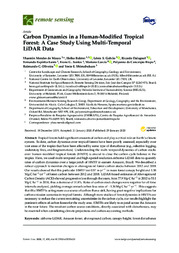Carbon dynamics in a human-modified tropical forest: a case study using multi-temporal LiDAR Data.
Carbon dynamics in a human-modified tropical forest: a case study using multi-temporal LiDAR Data.
Author(s): MOURA, Y. M. de; BALZTER, H.; GALVÃO, L. S.; DALAGNOL, R.; ESPÍRITO-SANTO, F.; SANTOS, E. G.; GARCIA, M.; BISPO, P. da C.; OLIVEIRA JUNIOR, R. C. de; SHIMABUKURO, Y. E.
Summary: Tropical forests hold significant amounts of carbon and play a critical role on Earth´s climate system. To date, carbon dynamics over tropical forests have been poorly assessed, especially over vast areas of the tropics that have been affected by some type of disturbance (e.g., selective logging, understory fires, and fragmentation). Understanding the multi-temporal dynamics of carbon stocks over human-modified tropical forests (HMTF) is crucial to close the carbon cycle balance in the tropics. Here, we used multi-temporal and high-spatial resolution airborne LiDAR data to quantify rates of carbon dynamics over a large patch of HMTF in eastern Amazon, Brazil. We described a robust approach to monitor changes in aboveground forest carbon stocks between 2012 and 2018. Our results showed that this particular HMTF lost 0.57 m·yr−1 in mean forest canopy height and 1.38 Mg·C·ha-1 yr-1 of forest carbon between 2012 and 2018. LiDAR-based estimates of Aboveground Carbon Density (ACD) showed progressive loss through the years, from 77.9 Mg·C·ha-1 in 2012 to 53.1 Mg·C·ha-1 in 2018, thus a decrease of 31.8%. Rates of carbon stock changes were negative for all time intervals analyzed, yielding average annual carbon loss rates of -1.34 Mg·C·ha−1·yr−1. This suggests that this HMTF is acting more as a source of carbon than a sink, having great negative implications for carbon emission scenarios in tropical forests. Although more studies of forest dynamics in HMTFs are necessary to reduce the current remaining uncertainties in the carbon cycle, our results highlight the persistent effects of carbon losses for the study area. HMTFs are likely to expand across the Amazon in the near future. The resultant carbon source conditions, directly associated with disturbances, may be essential when considering climate projections and carbon accounting methods
Publication year: 2020
Types of publication: Journal article
Unit: Embrapa Eastern Amazon
Keywords: Amazonia, Carbono, Floresta Tropical
Observation
Some of Embrapa's publications are published as ePub files. To read them, use or download one of the following free software options to your computer or mobile device. Android: Google Play Books; IOS: iBooks; Windows and Linux: Calibre.
Access other publications
Access the Agricultural Research Database (BDPA) to consult Embrapa's full library collection and records.
Visit Embrapa Bookstore to purchase books and other publications sold by Embrapa.

